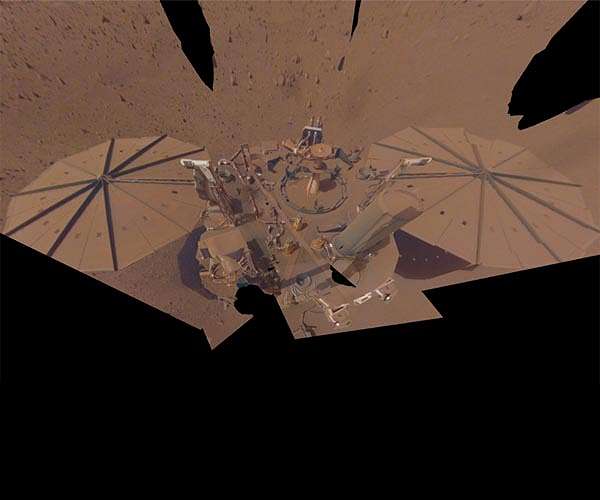
NASA’s InSight spacecraft on Mars nears final days (Image Credit: Space Daily)
NASA’s InSight spacecraft is nearing the end of its life after four years on Mars.
The Mars InSight lander was sent to the Red Planet in 2018 to study its crust, mantle and core. Heavy dust buildup on its solar panels, the chief source of its power supply, is bringing it within weeks of becoming inoperable, NASA said Tuesday.
Officials said the lander is operating at about 20% of its previous power level.
The space agency detailed its plans for InSight before it ultimately goes offline. The lander is observed and operated by a team of 20 to 30 technicians and scientists collecting data on and beneath Mars’ surface, including seismic activity.
More than 1,300 marsquakes have been recorded since InSight landed Nov. 26, 2018.
Before InSight’s mission is finished, the team will store all of the data collected, eventually making it available to researchers around the world. Much has been learned about the soil, core and even weather on Mars, the space agency said.
“Finally, we can see Mars as a planet with layers, with different thicknesses, compositions,” said Bruce Banerdt of NASA’s Jet Propulsion Laboratory, the mission’s principal investigator.
“We’re starting to really tease out the details. Now, it’s not just this enigma; it’s actually a living, breathing planet.”
The InSight team has been scaling back power consumption since summer. Members shut down several of its instruments to prolong the the seismometer’s operation.
The end of the InSight may be any day now. It is projected to be within the coming weeks, barring a windstorm that miraculously clears the dust from its solar panels. NASA will officially declare the mission ended when InSight misses two consecutive communication sessions.
“We’ll keep making science measurements as long as we can,” Banerdt said. “We’re at Mars’ mercy. Weather on Mars is not rain and snow; weather on Mars is dust and wind.”
InSight has spent 1,398 sols on Mars, a measure of solar days, which are about 3% shorter than a day on Earth.
Related Links
Mars News and Information at MarsDaily.com
Lunar Dreams and more
|
|
Tweet |
|
|
|
We need your help. The SpaceDaily news network continues to grow but revenues have never been harder to maintain. With the rise of Ad Blockers, and Facebook – our traditional revenue sources via quality network advertising continues to decline. And unlike so many other news sites, we don’t have a paywall – with those annoying usernames and passwords. Our news coverage takes time and effort to publish 365 days a year. If you find our news sites informative and useful then please consider becoming a regular supporter or for now make a one off contribution. |
||
|
SpaceDaily Contributor $5 Billed Once credit card or paypal |
SpaceDaily Monthly Supporter $5 Billed Monthly paypal only |
|
ANU scientists use deep planetary scan to confirm Martian core
Canberra, Australia (SPX) Oct 28, 2022
Seismologists from The Australian National University (ANU) have developed a new method to scan the deep interior of planets in our solar system to confirm whether they have a core at the heart of their existence.
The scanning method, which works in a similar way to an ultrasound scan using sound waves to generate images of a patient’s body, requires only a single seismometer on a planet’s surface in order to work. It can also be used to confirm the size of a planet’s core. The research is publish … read more









